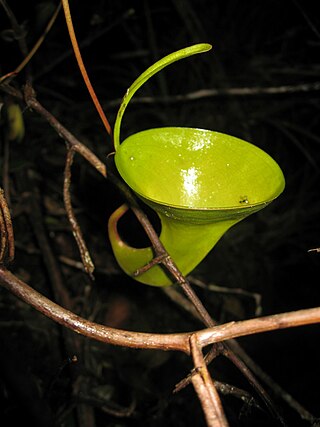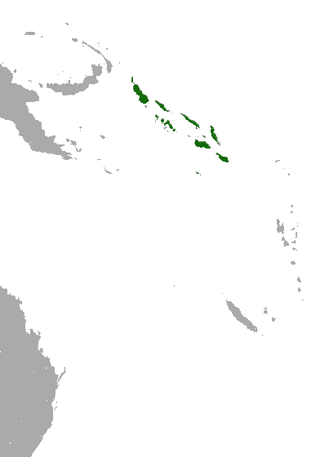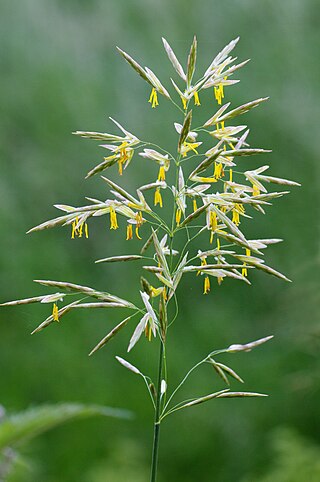
Bromus is a large genus of grasses, classified in its own tribe Bromeae. They are commonly known as bromes, brome grasses, cheat grasses or chess grasses. Estimates in the scientific literature of the number of species have ranged from 100 to 400, but plant taxonomists currently recognize around 160–170 species.

The water deer is a small deer species native to Korea and China. Its prominent tusks, similar to those of musk deer, have led to both subspecies being colloquially named vampire deer in English-speaking areas to which they have been imported. It was first described to the Western world by Robert Swinhoe in 1870.

Nepenthes dubia is a tropical pitcher plant endemic to the Indonesian island of Sumatra, where it grows at an altitude of 1600–2700 m above sea level. The specific epithet dubia is the Latin word for "doubtful".

Nepenthes inermis is a tropical pitcher plant endemic to the Indonesian island of Sumatra. The specific epithet inermis is Latin for "unarmed" and refers to the upper pitchers of this species, which are unique in that they completely lack a peristome.

Stomatosuchus is an extinct stomatosuchid neosuchian from the Late Cretaceous (Cenomanian) of Egypt. Much of what is known about Stomatosuchus has been inferred from the related genus Laganosuchus.

Nepenthes × pyriformis is a natural hybrid involving N. inermis and N. talangensis. It is known only from Mount Talang in Sumatra, to which N. talangensis is endemic. Nepenthes talangensis was only described as a distinct species in 1994. Prior to this it was placed within N. bongso and some of the older literature identifies this hybrid as N. bongso × N. inermis.

The Solomon's naked-backed fruit bat is a species of megabat in the family Pteropodidae. It is endemic to the Solomon Islands.

The highlands punaré is a caviomorph rodent of South America from the spiny rat family. It is endemic to gallery forest, savanna and rocky outcrop habitats in Bahia State within the Caatinga ecoregion of eastern Brazil at elevations from 260 m to 1030 m. It sometimes nests and often takes refuge in crevices in rock formations, as means of both predator avoidance and moderating temperature extremes. The species tolerates a degree of habitat disturbance. Although hunted, it is considered common throughout its range. Its karyotype has 2n = 26 and FN = 48.

Bromus inermis is a species of the true grass family (Poaceae). This rhizomatous grass is native to Europe and considered invasive in North America.

Sebastes inermis, the Japanese red seaperch or dark-banded rockfish, is a species of marine ray-finned fish belonging to the subfamily Sebastinae, the rockfishes, part of the family Scorpaenidae. It is found in the northwestern Pacific Ocean. This species is known as mebaru in Japan and as bollak (볼락) in Korea.

Sepiella inermis is a species of cuttlefish in the family Sepiidae. S. inermis is indigenous to the Indo-Pacific region. In this region, Sepiella inermis is an economically important species, and is sold and eaten.

Hammatoderus is a genus of longhorn beetles of the subfamily Lamiinae, containing the following species:
Hammatoderus albatus is a species of beetle in the family Cerambycidae. It was first described by Henry Walter Bates in 1880. It is known from Panama and Costa Rica.

Hammatoderus lunaris is a species of beetle in the family Cerambycidae. It was described by Henry Walter Bates in 1880. It is known from Mexico.

Hammatoderus maculosus is a species of beetle in the family Cerambycidae. It was described by Henry Walter Bates in 1880. It is known from Guatemala, El Salvador, Mexico, Honduras, Belize, and Nicaragua.
Hammatoderus ornator is a species of beetle in the family Cerambycidae. It was described by Henry Walter Bates in 1885. It is known to exist in Mexico.
Hammatoderus elatus is a species of beetle in the family Cerambycidae. It was described by Henry Walter Bates in 1872. It is known from Mexico, Costa Rica, Ecuador, Colombia, Honduras, Panama, and Nicaragua.

Hammatoderus rubefactus is a species of beetle in the family Cerambycidae. It was described by Henry Walter Bates in 1872. It is known from Nicaragua, Mexico, Costa Rica, and Panama.
Hammatoderus lacordairei is a species of beetle in the family Cerambycidae. It was described by James Thomson in 1860. It is known from Panama and Mexico.
Hammatoderus colombiensis is a species of beetle in the family Cerambycidae. It was described by Constantino, Benavides and Esteban in 2014. It is known from Colombia.















